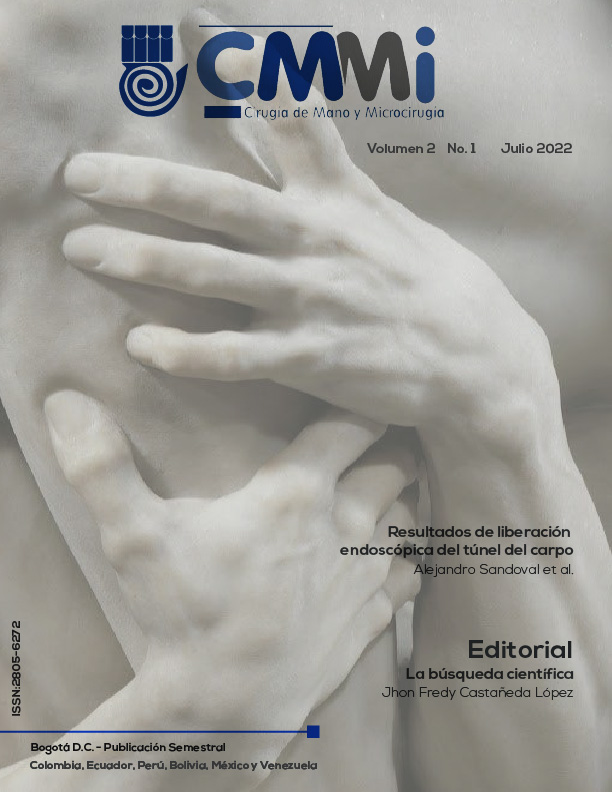Left supraclavicular lipoma associated with the brachial plexus trunks. Case report
DOI:
https://doi.org/10.25214/28056272.1487Keywords:
Lipoma, Brachial Plexus Neuropathies, SurgeryAbstract
Introduction: Lipomas are the most common soft tissue tumors. However, its location in the brachial plexus is extremely rare. Clinically, they can be manifested by insidious compressive symptoms since they are involving the nerve structures and the treatment is surgical resection in indicated cases.
Materials and methods: The case of a 56-year-old patient with progressive edema of the left upper limb, episodic paresthesias, and weight sensation of two years of evolution is reported. Magnetic resonance imaging documented the presence of a 6 x 8 cm encapsulated mass located in the topography of the trunks and divisions of the left brachial plexus in intimate contact with the subclavian vessels. The treatment performed and literature review are described.
Conclusion: Lipomas associated with the brachial plexus trunks are rare benign entities with progressive growth that can cause compressive sensory and motor symptoms. Surgical treatment is a safe therapeutic option when is performed by a trained surgeon due to the risk of nerve injury during surgical resection of the mass.
Downloads
References
Mentzel T. Biological continuum of benign, atypical, and malignant mesenchymal neoplasms - does it exist? J Pathol. 2000;190(5):523-5. DOI: 10.1002/(SICI)1096-9896(200004)190:5<523::AID-PATH578>3.0.CO;2-#.
Flores LP, Carneiro JZ. Peripheral nerve compression secondary to adjacent lipomas. Surg Neurol. 2007;67(3):258-62. DOI: 10.1016/j.surneu.2006.06.052.
Kim DH, Murovic JA, Tiel RL, Moes G, Kline DG. A series of 146 peripheral non-neural sheath nerve tumors: 30-year experience at Louisiana State University Health Sciences Center. J Neurosurg. 2005;102(2):256-66. DOI: 10.3171/jns.2005.102.2.0256.
Sergeant G, Gheysens O, Seynaeve P, Van Cauwelaert J, Ceuppens H. Neurovascular compression by a subpectoral lipoma. A case report of a rare cause of thoracic outlet syndrome. Acta Chir Belg. 2003;103(5):528-31. DOI: 10.1080/00015458.2003.11679484.
Graf A, Yang K, King D, Dzwierzynski W, Sanger J, Hettinger P. Lipomas of the Brachial Plexus: A Case Series and Review of the Literature. Hand (N Y). 2019;14(3):333-8. DOI: 10.1177/1558944717735946.
Marek T, Amrami KK, Mahan MA, Spinner RJ. Intraneural lipomas: institutional and literature review. Acta Neurochir (Wien). 2018;160(11):2209-18. DOI: 10.1007/s00701-018-3677-7.
Sureka J, Cherian RA, Alexander M, Thomas BP. MRI of brachial plexopathies. Clin Radiol. 2009;64(2):208-18. DOI: 10.1016/j.crad.2008.08.011.
Hsu PC, Chang KV, Mezian K, Naňka O, Wu WT, Yang YC, et al. Sonographic Pearls for Imaging the Brachial Plexus and Its Pathologies. Diagnostics (Basel). 2020;10(5):324. DOI: 10.3390/diagnostics10050324.
Huang JH, Zaghloul K, Zager EL. Surgical management of brachial plexus region tumors. Surg Neurol. 2004;61(4):372-8. DOI: 10.1016/j.surneu.2003.08.006.
Gembruch O, Ahmadipour Y, Chihi M, Dinger TF, Rauschenbach L, Pierscianek D, et al. Lipomas as an Extremely Rare Cause for Brachial Plexus Compression: A Case Series and Systematic Review. J Brachial Plex Peripher Nerve Inj. 2021;16(1):e10-e16. DOI: 10.1055/s-0041-1726087.
Brennan PA, Blythe JN, Herd MK, Habib A, Anand R. The contemporary management of chyle leak following cervical thoracic duct damage. Br J Oral Maxillofac Surg. 2012;50(3):197-201. DOI: 10.1016/j.bjoms.2011.02.001.
Downloads
Published
How to Cite
Issue
Section
License
Copyright (c) 2022 Cirugía de Mano y Microcirugía

This work is licensed under a Creative Commons Attribution 4.0 International License.
| Article metrics | |
|---|---|
| Abstract views | |
| Galley vies | |
| PDF Views | |
| HTML views | |
| Other views | |




